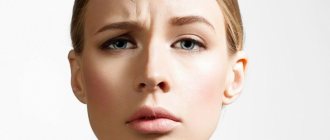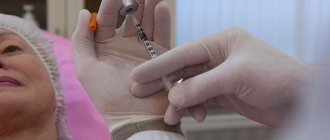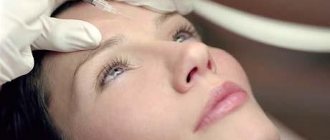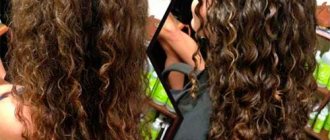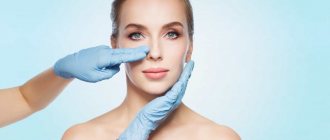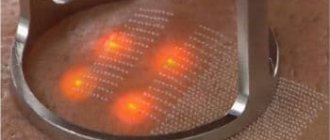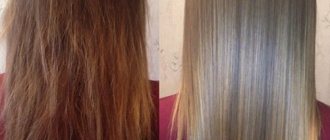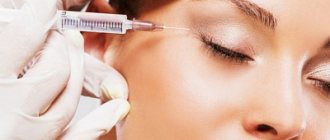Causes
An allergic reaction to Botox is rare. However, if the rules for using the drug were violated, then the likelihood of such a side effect increases several times.
An allergic reaction to botulinum toxin is rare. Sometimes it occurs due to additional ingredients included in the preparations.
To preliminarily determine the presence of an allergy, it is necessary to perform a skin test before the procedure.
For mild to moderate symptoms, taking antihistamines is sufficient. If a severe reaction develops, hospitalization is indicated.
In addition, experts identify another equally significant factor that can provoke such a negative reaction - this is the implementation of the procedure in the presence of characteristic contraindications.
Botox injections are prohibited if you are allergic to protein, have dermatological pathologies of the skin, or have chronic diseases. The limitation is the weakening of the immune system and the use of potent medications, with which botulinum toxin may be incompatible.
The patient’s tendency to have an allergic reaction to Botox is identified in advance.
The cosmetologist conducts a survey and finds out how the body reacts to the toxin and other components.To do this, they conduct an examination and take accompanying tests if the woman cannot clearly answer the specialist’s questions.
Cosmetologist, dermatologist, trichologist
Kalinina Olga Alexandrovna
4 years of experience
If we talk about Botox for hair, then the cause of an allergic reaction may be the substances present in the composition. These are, as a rule, elastin, keratin amino acids, fragrances, lactic acid and cosmetic oils.
Is it possible to find out about allergies before the procedure?
In order to determine whether there is a tendency to an allergic reaction to Botox before performing the manipulation, it is necessary to do a skin test in advance. This is one of the most effective ways to identify the body’s tendency to such negative manifestations.
The test is done as follows. First, the doctor leaves a small scratch on the patient’s hand. After this, a small amount of the composition that will be used during the procedure is taken and injected into the wound.
If a person has a tendency to develop allergies, redness and swelling will appear on the skin within an hour.
Difference between filler and botox
In the field of cosmetology, there is a wide variety of procedures that help fight signs of age-related changes and help improve skin firmness and elasticity.
If the test results in a positive result, it is repeated several times. In this case, various drugs will already be used, which contain butolin toxin.
It is in this way that it is possible to identify what exactly a person may have a negative reaction to.
Allergy to Botox: myth or reality?
For more than 25 years of active use in cosmetology, preparations based on botulinum toxin have established themselves as an effective and safe way to eliminate facial wrinkles. However, they may well cause serious problems for the patient.
Allergy to Botox is an extremely rare and little-studied complication. Nevertheless, such a reaction is indeed possible, although most often it is caused not by the toxin itself, but by stabilizer proteins and other substances with which the patient somehow comes into contact during the procedure. What symptoms should you pay attention to during and after injections? What should the treatment be? Do I need to take any tests in advance? Is there reliable prevention? TecRussia.ru answers the most pressing questions:
↑ Let's analyze the composition of drugs: which components are safe and which ones should be wary of?
The main active substance of Botox and all its analogues is botulinum toxin type A. As medical statistics show, a small number of patients have an increased susceptibility to this component. It manifests itself in the fact that even a small dosage leads to severe muscle paralysis in the injection area. This feature can complicate the injections and negatively affect their results, however, there is currently no confirmed scientific evidence that the toxin can also cause an immune response in the form of an allergy. But such troubles can be caused by excipients that are included in cosmetic preparations for botulinum therapy:
- the original Botox, as well as Relatox and Botulax, contain the human protein albumin;
- in Dysport - albumin and lactose;
- in Lantox, Xeomin and Refinex - sucrose, etc.
These components are able to cause a full-fledged allergic reaction in those patients whose body was initially hypersensitive to them. As a rule, it proceeds relatively easily and does not directly threaten life or health, but it can still spoil the appearance and also negatively affect overall well-being.
In addition, all modern botulinum toxins must be diluted to a lower concentration before use. According to the protocol, only saline solution – 0.9% sodium chloride – can be used for this. But some cosmetologists, due to their inexperience or desire to experiment, add lidocaine to the resulting “cocktail” - and, as you know, it is extremely ambiguously perceived by our immune system and can cause very serious problems, even anaphylactic shock. Also, a fairly large amount of lidocaine may be contained in the anesthetic cream, which is almost always applied to the skin before injections to make them more comfortable.
Thus, allergies to Botox do happen. At the same time, botulinum toxin itself in small medical dosages can be considered safe, but the real cause of unwanted reactions in the body are the auxiliary components of the drug, as well as the anesthesia used in preparation for injections.
↑ Is it possible to identify the problem in advance? What tests should I take?
The most effective way to determine your body’s sensitivity to an injection product is a skin test, which any cosmetologist can perform:
- A small cut or scratch is made on the patient’s wrist, into which a small amount of the test substance is then injected, in our case several units of Botox or another botulinum toxin-based product.
- If you have an allergy, clearly visible symptoms will appear in this area within 1 hour: redness, swelling, etc.
If the test is positive, it will need to be repeated several more times using different drugs to understand which component is causing the problem - most often it is a stabilizing protein or sugars.
Due to the overall low number of allergic complications associated with Botox, many doctors consider it necessary to perform a skin test only on patients who have already encountered any problematic consequences of injections. However, those who are generally prone to hypersensitivity reactions or doubt that the body will react normally to all components of the chosen drug should also insist on carrying out this simple, quick and very informative analysis.
↑ Alarming symptoms: what to pay special attention to?
The administration of botulinum toxin can be accompanied by both local and general allergic manifestations. In the first case, one or more of the following symptoms occur:
- redness of the skin in the injection area;
- severe increasing swelling of the treated area, sometimes painful (see more in the article about the types of swelling after Botox);
- local or general increase in temperature;
- difficulty moving the eyelids, eyebrows or lips, swallowing, etc. - depending on where exactly the injections were given;
- itching in the injection area or dispersed throughout the body;
- peeling of the skin;
- dysarthria.
Such deviations may appear within 5-10 minutes after administration of the drug, but more often the patient notices unpleasant changes several hours, and sometimes even days after the session. They do not always indicate exactly an intolerance reaction: for example, redness and swelling are considered a normal consequence of injuries from injections, and difficulty swallowing and other problems with muscle activity may indicate the presence of another complication - strong diffusion of the drug. Therefore, it is advisable that the final conclusion about their character be made by a cosmetologist during an in-person examination (for more details, see also the article “Complications after Botox”).
The second group - general allergic reactions - includes Quincke's edema and anaphylactic shock. These conditions are much more dangerous, and their signs appear instantly, literally “at the tip of the needle”:
- severe, rapidly increasing swelling of the face;
- feeling of lack of air;
- tremor of the limbs and whole body;
- a sharp drop in blood pressure;
- tachycardia (increased heart rate);
- the appearance of cold sticky sweat;
- depression of consciousness.
Typically, such problems arise already during the injections, but if they appear and increase in the early post-procedure period, you should immediately contact any available doctor to accurately determine their cause and begin treatment.
↑ What to do if signs of allergies appear after Botox?
Minor local symptoms of hypersensitivity, as a rule, do not require special treatment: the main task here is to make sure that we are not talking about any more serious complication. Further therapy comes down to taking tableted antihistamines: Eden, Claritin, Loratadine, Suprastin, Tavegil, etc.
- Why does my head hurt after Botox: causes and solutions to the problem
- Allergy to hyaluronic acid: fact or fiction?
More serious malfunctions of the body - Quincke's edema and anaphylactic shock - require immediate medical attention. Fortunately, they happen extremely rarely, and in most cases - as a reaction to lidocaine used for injections (and patients usually find out about this intolerance long before visiting a cosmetologist). However, everyone should know the general principles of first aid for these pathologies:
- if an allergic reaction develops directly during the procedure, ask the specialist to stop administering Botox;
- take an antihistamine;
- apply cold to the treated area - this will constrict the blood vessels and reduce swelling;
- provide fresh air access to the room;
- call an ambulance;
- in especially severe cases, it is necessary to administer hormonal drugs that suppress the immune response, such as Prednisolone or Dexamethasone.
↑ Preventive measures: is it possible to insure against unpleasant consequences?
Despite the fact that the main effects of Botox and its analogues have been well studied, serious scientific studies that would determine the incidence and characteristics of allergies to these drugs have not yet been conducted. At present, it is possible to give only those recommendations that are based on the practical experience of doctors and patients:
- The total number of cases of individual hypersensitivity to botulinum toxin and auxiliary components is extremely small, and their manifestations do not threaten life or health. Therefore, for people who are generally not prone to allergic reactions, no special prophylaxis is required before the session.
- At the same time, it is extremely important to make sure in advance that your body normally accepts lidocaine - it is this that most often causes Quincke's edema and anaphylaxis. To completely secure the procedure, you must ask the cosmetologist to use other types of anesthetics.
- Those who have already experienced Botox intolerance, even in the mildest form, should avoid further injections until the allergen is accurately identified. It is known that with each subsequent session the hypersensitivity reaction intensifies: what looked like insignificant redness or swelling the first time can take on a much more dangerous form already in the second.
- To determine which component our body reacts so acutely to, it is necessary to conduct several skin tests. As a rule, based on their results, you can choose your own safe brand of drug for each patient: for example, for those who are lactose intolerant, any brand except Dysport is suitable, and for those who “do not work” with albumin, you can use Lantox or Xeomin.
- In those extremely rare cases when the problem is caused precisely by individual intolerance to botulinum toxin type A, you will have to completely abandon injections and choose one of the alternative wrinkle correction methods - for example, hardware skin tightening or fillers based on hyaluronic acid.
↑ Briefly about the most important
Botox and its analogues can cause allergies, but in the vast majority of cases it is caused not by the main active substance, but by the auxiliary components of the drugs or the anesthetic used. Symptoms, as a rule, are not life-threatening or health-threatening, but tend to intensify with each subsequent session.
| What should the patient do: | |
| Before the procedure |
|
| If allergy symptoms appear during the procedure |
|
| If symptoms occur at home |
|
In general, for any atypical manifestations after botulinum toxin injections, it is advisable not to self-medicate and consult a doctor immediately. The fact is that people often tend to attribute any newly emerging symptoms to the consequences of “beauty injections,” which in fact can be caused by completely different reasons. Only a complete diagnosis will allow you to accurately determine the source of trouble and choose the best way to eliminate it.
How it manifests itself
Signs of an allergy to drugs containing butolotoxin can appear not only a few hours after the manipulation, but already at the time when the specialist is just administering the drug.
In situations where there is a slight manifestation of hypersensitivity, it is enough to use antihistamine medications.
If symptoms are severe, it is recommended to immediately seek medical help.
An allergic reaction to Botox can manifest as a local and general clinical picture.
Local symptoms, as a rule, can be observed immediately or several days after administration of the substance. It is worth noting that some of the manifestations do not always indicate an allergy. Sometimes it is a normal phenomenon in response to injury, puncture or bruise.
The most common signs of local significance include redness of the skin, itching, peeling, dysarthria, pain at the puncture site, swelling, and increased body temperature.
Among common allergic manifestations, experts highlight anaphylactic shock and Quincke's edema. Such conditions are often observed during the injection process and pose a serious danger not only to health, but also to human life.
Why can our articles be trusted?
We make health information clear, accessible and relevant.
- All articles are checked by practicing doctors.
- We take scientific literature and the latest research as a basis.
- We publish detailed articles that answer all questions.
Common reactions include a rapid decrease in blood pressure, confusion, increased sweating, tremors of the upper and lower extremities or the whole body, rapid heartbeat, and a feeling that there is not enough air.
Botox and Dysport: which is better?
- Botox
- Botox and Dysport: which is better?
- Botox and Relatox
- Botox and Xeomin
Many people wonder what is better to use: Botox or Dysport.
Let's compare the two drugs. It should be immediately noted that both of these products are based on botulinum toxin type A and a number of excipients. The main active component of both products is the waste product of the bacterium Clostridium botulinum, a chemical substance that has the ability to block the conduction of nerve impulses in muscle tissue, as a result of which the muscles relax and cease to respond to external stimuli. Main differences and scope of application
These drugs differ from each other in a different approach to determining units of activity, and therefore differences in their so-called “pharmacological fullness” are revealed (100 units of Botox are approximately equal to 500 units of Dysport). Other differences relate to the molecular weight of toxin-non-toxin proteins, which for Botox is 900 kDa, while for Dysport it is only 500 kDa. Taking into account the dependence of molecular weight on the diffusion rate, we can conclude that Dysport is more susceptible to spreading beyond the correction zone. This feature should be taken into account when carrying out botulinum therapy for facial wrinkles, since the predictability of results is noticeably reduced. However, when eliminating signs of hyperhidrosis, greater diffusion of Dysport should be regarded as an advantage.
Studies of tolerability, effectiveness and duration of action of both drugs have shown that there are no significant differences between them
Dysport and Botox have found application both in neurology (in the treatment of cerebral palsy, blephorospasm, etc.) and in cosmetology to eliminate wrinkles. Folds are noticeably smoothed out, and the tired, dull appearance of the face disappears.
Manufacturers of these drugs are different. Botox is produced by the American company Allergan. Dysport is manufactured by the French company Beaufour Ipsen International at one of the factories in England. In Russia, Botox has been used since 1994. Dysport began to be used a little later, and cosmetologists from leading domestic medical and cosmetology centers prefer to inject Botox, but Dysport is less popular.
Indications for use:
- Expression wrinkles of the face;
- Folds between the eyebrows;
- Correction of the forehead area;
- Correction of the nasal bridge;
- "Crow's feet" in the corners of the eyes;
- Hyperhidrosis (increased sweating).
The action of the drugs is aimed at eliminating facial wrinkles, the so-called “crow’s feet” around the eyes, transverse wrinkles on the forehead, as well as folds around the lips and between the eyebrows. Botox and Dysport are effective against facial asymmetry. The drug begins to act immediately after administration, the maximum effect is achieved after 2-5 days. Duration – from 4 months to 6 months.
Thus, having made a comparative description of the two drugs, we come to the conclusion that these are identical drugs, differing only in the dosage method (Botox - 100 units and Dysport - 500 units). In our country, Dysport is used less often than Botox. In our center, along with the drug Xeomin, we use Botox.
